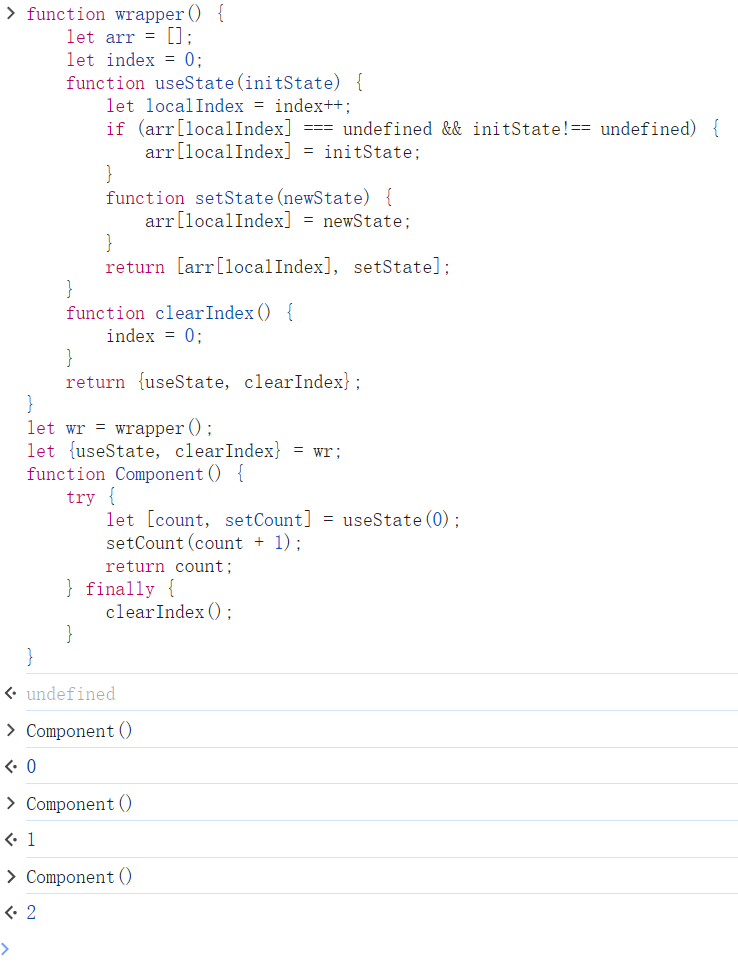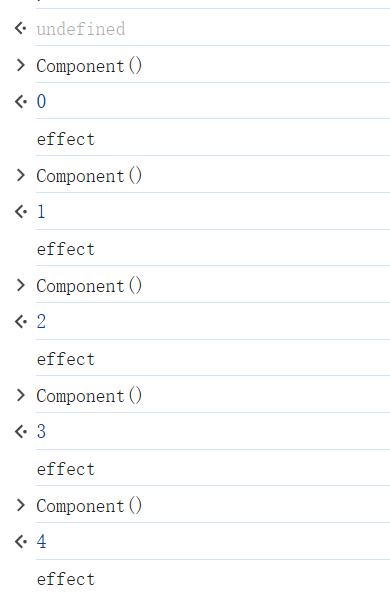react的hook是如何实现的
useState
useState的用法如下,返回一个数组,数组的第一个元素是状态值,第二个元素是状态值的更新函数。
而组件的渲染都是需要运行组件这个函数本身的,那这里就会有一个问题,下面useState这一行,在每次组件渲染的时候都会重新运行,可这样的话,count是怎么拿到之前的状态值呢?
function Component() {
let [count, setCount] = useState(0);
setCount(count + 1);
return count;
}
秘密大概就是useState使用了数组来记录这些状态:
// 首先有一个记录该组件多种状态信息的wrapper,主要就是有个arr数组
// 对应一个组件中多次useState
function wrapper() {
let arr = [];
let index = 0;
function useState(initState) {
let localIndex = index++;
// 如果设置了初值
if (arr[localIndex] === undefined && initState!== undefined) {
arr[localIndex] = initState;
}
// setState修改当前下标的值
function setState(newState) {
arr[localIndex] = newState;
}
// 返回初值 和 setState函数
return [arr[localIndex], setState];
}
function clearIndex() {
index = 0;
}
return {useState, clearIndex};
}
let wr = wrapper();
let {useState, clearIndex} = wr;
function Component() {
try {
let [count, setCount] = useState(0);
setCount(count + 1);
return count;
} finally {
clearIndex();
}
}

通俗点解释:在import引入useState的时候,其实就是执行了wrapper函数,创建了一个记录着数组变量的闭包对象,对于当前组件的所有状态值,都保存在这个数组中,第一次使用useState的代码对应数组的第0个元素,依次类推。
这其实就解释了为什么每次渲染是重新运行Component(),但是count还能像全局state一样保存,就是因为count是存到了wr这个对象中的,而wr对应的就是import {useState} from 'react',在import的过程中,创建了这样一个匿名的对象来存储当前组件的状态值列表。
当然为了每次渲染之前index都能归零,所以有clearIndex这一步。
useEffect
我们在上面的例子基础上添加:
function wrapper() {
let arr = [];
let index = 0;
function useState(initState) {
let localIndex = index++;
if (arr[localIndex] === undefined && initState!== undefined) {
arr[localIndex] = initState;
}
function setState(newState) {
arr[localIndex] = newState;
}
return [arr[localIndex], setState];
}
function clearIndex() {
index = 0;
}
function useEffect(callback, deps) {
let localIndex = index++;
if (!deps) {
setTimeout(callback, 0);
return;
}
for(var i=0; i<deps.length; i++) {
if (deps[i] != arr[localIndex][i]) {
setTimeout(callback, 0);
return;
}
}
}
return {useState, clearIndex, useEffect};
}
let wr = wrapper();
let {useState, clearIndex, useEffect} = wr;
function Component() {
try {
let [count, setCount] = useState(0);
useEffect(()=>{console.log("effect")})
setCount(count + 1);
return count;
} finally {
clearIndex();
}
}

useEffect的执行是异步的,也就是说useEffect的回调函数会在下一个事件循环中执行,setTimeout(0)就是最简单的实现方式,而useEffect的依赖数组,其实就是当前组件的状态值列表,当状态值发生变化的时候,就会执行useEffect的回调函数。
react中useEffect的用法中还有一项是,callback的返回值是个函数,会在组件卸载的时候执行,用来清理一些状态值,这里我们就不模拟了,因为我们只是在了解数据的状态转移,并没有涉及到组件的渲染和卸载,这是react中另外一个话题。当然这个功能其实也不难,比如直接搞一个新的数组,用类似的方式来记录callback的返回值,当组件卸载的时候,遍历这个数组,执行其中的函数即可。